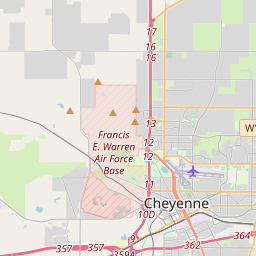The Cheyenne Opera House and Territorial Library
Historical marker location:
200 West 17th Street, Cheyenne, Wyoming
( Marker is on West 17th Street near Capitol Avenue, on the right when traveling west.)
Marker installed: 1963







© OpenStreetMap contributors
Loading...
Searching for other points of interest within 3 miles of this location.The famous outlaw Butch Cassidy, whose real name was Robert LeRoy Parker, owned a ranch in Wyoming. The ranch was called the Hole-in-the-Wall, and it was located in the remote Johnson County area. The Hole-in-the-Wall was a notorious hideout for outlaws and a place where they could hide from the law.
About Laramie County
Laramie County Timeline
Laramie County, located in southeastern Wyoming, has a rich and diverse history that dates back thousands of years. The area was originally inhabited by Native American tribes such as the Arapaho, Cheyenne, and Sioux, who relied on the abundant wildlife and natural resources of the region for their livelihoods. The arrival of European fur traders in the early 19th century brought increased interaction and trade with the Native Americans.
The area that would later become Laramie County was officially established in 1867, when Wyoming was still part of the Dakota Territory. It was named after Jacques La Ramee, a French-Canadian fur trapper who explored the region in the early 1800s. The establishment of Fort Laramie in the mid-19th century played a significant role in the county's history, serving as a major military outpost and a hub for fur trade and westward migration.
The county experienced rapid development and growth with the arrival of the Union Pacific Railroad in the late 1860s, which connected the region to the eastern United States. The railroad brought an influx of settlers and entrepreneurs who established towns and ranches in the area, laying the foundation for what would become the modern-day cities of Cheyenne and Laramie.
Over the years, Laramie County has played an important role in Wyoming's economy. It became the state capital in 1869 when Wyoming officially became a territory, and Cheyenne continues to serve as the capital to this day. The region has seen booms and busts in various industries, including cattle ranching, coal mining, and oil exploration, all of which have shaped the county's economy and identity. Today, Laramie County is a vibrant community that celebrates its Western heritage while embracing new industries and opportunities.
The area that would later become Laramie County was officially established in 1867, when Wyoming was still part of the Dakota Territory. It was named after Jacques La Ramee, a French-Canadian fur trapper who explored the region in the early 1800s. The establishment of Fort Laramie in the mid-19th century played a significant role in the county's history, serving as a major military outpost and a hub for fur trade and westward migration.
The county experienced rapid development and growth with the arrival of the Union Pacific Railroad in the late 1860s, which connected the region to the eastern United States. The railroad brought an influx of settlers and entrepreneurs who established towns and ranches in the area, laying the foundation for what would become the modern-day cities of Cheyenne and Laramie.
Over the years, Laramie County has played an important role in Wyoming's economy. It became the state capital in 1869 when Wyoming officially became a territory, and Cheyenne continues to serve as the capital to this day. The region has seen booms and busts in various industries, including cattle ranching, coal mining, and oil exploration, all of which have shaped the county's economy and identity. Today, Laramie County is a vibrant community that celebrates its Western heritage while embracing new industries and opportunities.
Laramie County Timeline
This timeline provides a concise overview of the key events in the history of Laramie County, Wyoming.
- 1867: Laramie County is founded and named after Jacques La Ramée, a French-Canadian fur trapper.
- 1868: Fort D.A. Russell is established near present-day Cheyenne, becoming an important military outpost during the Indian Wars.
- 1869: Cheyenne is designated as the capital of Wyoming Territory.
- 1887: Cheyenne becomes one of the first cities in the world to have electric streetlights.
- 1920: The first commercial airport in Wyoming, Cheyenne Municipal Airport, is opened.
- 1959: F.E. Warren Air Force Base is transferred to the Strategic Air Command, playing a crucial role during the Cold War.
- 1987: The Wyoming State Capitol in Cheyenne is added to the National Register of Historic Places.